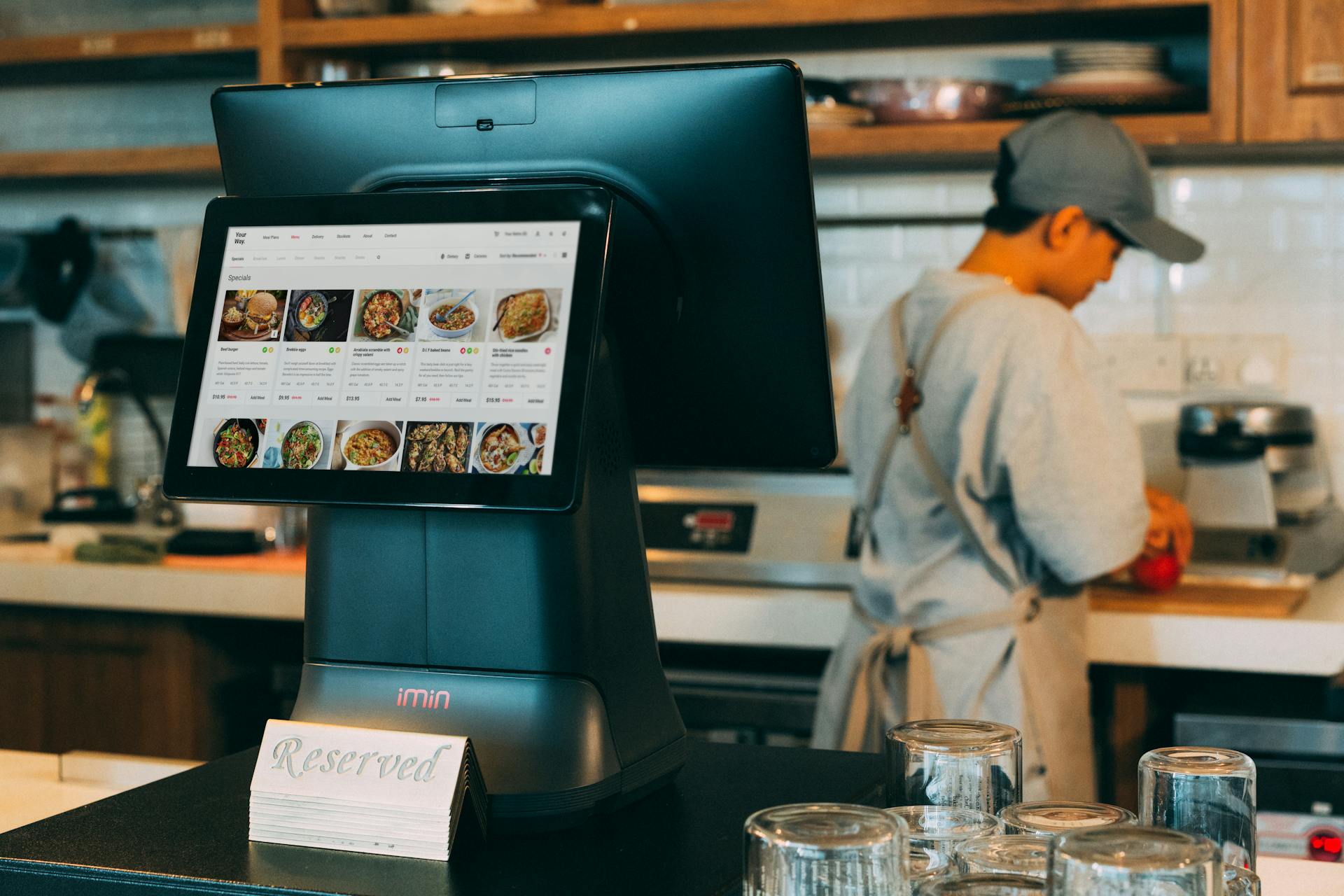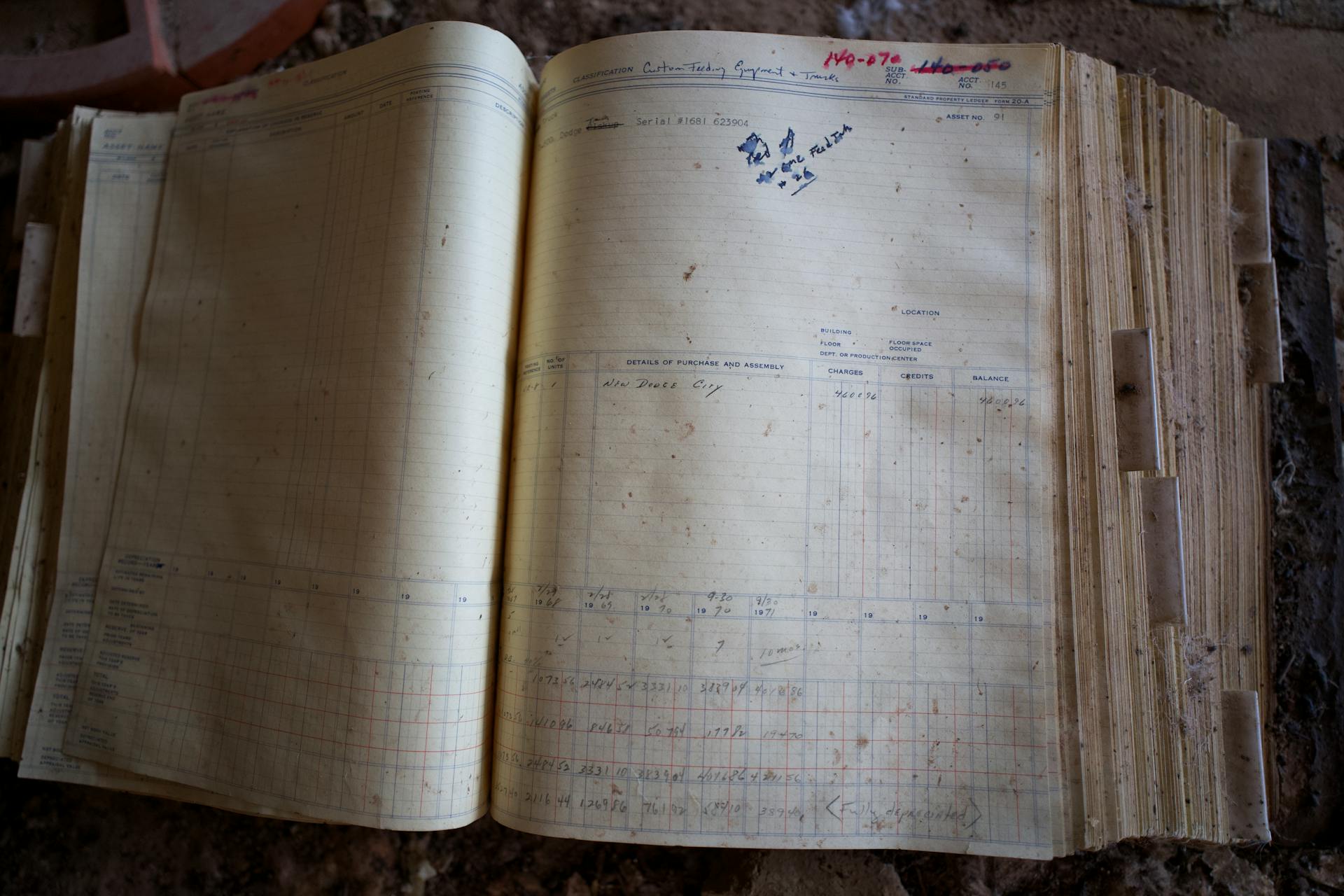
Prepaid expenses are a type of asset that businesses pay for in advance of receiving the benefit. This can include rent, insurance, and utilities.
Prepaid expenses are recorded as an asset on the balance sheet because they represent a future benefit that has been paid for. This is in contrast to expenses that are incurred as they are used.
A prepaid expense journal entry is made when a business pays for a benefit that will be received in the future. This entry typically involves debiting the prepaid expense account and crediting cash.
Prepaid expenses can be a valuable asset for businesses, as they can provide a cost savings and improve cash flow.
Additional reading: Journal Entry for Receiving Cash in Advance
What Is Prepaid Expense?
A prepaid expense is essentially any payment you make for something before you actually use it. This can be a common occurrence in small businesses.
Rent is a prime example of a prepaid expense, as you're paying for a commercial space before you even start using it.
Paying for small business insurance policies is another common prepaid expense.
Equipment you pay for before using it is also considered a prepaid expense. This can include things like computers, machinery, or any other type of equipment your business needs to operate.
Salaries are typically prepaid expenses, unless you're running payroll in arrears. This means you're paying your employees before they've actually earned the money.
Estimated taxes are also a type of prepaid expense. This is because you're paying taxes on income you haven't yet earned.
Some utility bills, such as electricity or water, can also be prepaid expenses.
Recording Prepaid Expense
Recording prepaid expenses is a straightforward process that starts with identifying the prepaid expense. Prepaid expenses are transactions a company pays in advance to cover goods or services that the business will receive over a future period, usually twelve months.
To record a prepaid expense, you'll typically input it on the balance sheet as a current asset. For example, if a company pays a $12,000 premium for directors' and officers' liability insurance, the initial entry would be to debit the prepaid expense account and credit the account used to pay for the expense.
For more insights, see: What to Debit and Credit in a Write off Account
The prepaid expense account is usually reduced by the amount of the expense as it's incurred, and the expense is recognized on the income statement in the period when it was incurred. Businesses can't claim a deduction in the current year for prepaid expenses for future years.
To make adjusting entries for prepaid expenses, you'll divide the total prepaid expense by the number of months it covers. For instance, if a company prepaying for office space for six months in advance, totaling $24,000, the monthly adjusting entry would be to reduce the prepaid rent balance sheet account by the monthly rent amount, which is $4,000 per month.
The initial entry for prepaid expenses can be recorded as a debit to the prepaid expense account and a credit to the account used to pay for the expense. For example, if a company buys a $12,000 insurance policy, the initial entry would be to debit the prepaid insurance account and credit the cash account.
If this caught your attention, see: An Adjusting Entry for Accrued Expenses Involves
Adjusting Entries
Adjusting entries are a crucial part of accounting for prepaid expenses. They help balance your books by recognizing prepaid expenses that become actual expenses over time.
To create an adjusting entry, you need to debit your Expense account and credit your Prepaid Expense account. This process creates a prepaid expense adjusting entry.
For example, if you prepay six month's worth of rent, which adds up to $6,000, you'll decrease the asset account by $1,000 each month until the expense is used up.
You'll know you've reached this point when the balance of the prepaid asset account equals $0.
Here's a step-by-step guide to creating adjusting entries:
- Calculate the portion of the prepaid expense that applies to a particular period by dividing the total prepaid amount by the number of amortization periods.
- Reduce the prepaid asset account and increase the expense account for each period.
- Continue this cycle of steps until the business fully realizes the benefit it purchased.
For instance, if you prepay $12,000 for insurance and follow a quarterly accounting cycle, you'll allocate $3,000 to each quarter. Each quarter, you'll enter a debit of $3,000 to reflect the expense and a matching credit to the prepaid insurance asset.
Here's an example of what your journal entry might look like:
Examples and Guides
Recording prepaid expenses can be a bit tricky, but understanding how it works will make it easier to manage your company's finances.
To illustrate this, let's look at Big Corp.'s payment for a three-year equipment maintenance contract, which is a classic example of a prepaid expense.
Big Corp. paid $240,000 upfront for the contract, and Taylor, the junior accountant, allocated $80,000 to the current year as a current asset and the remaining $160,000 to long-term assets. This is a common approach to recording prepaid expenses, where you allocate the cost over the useful life of the asset.
The most common examples of prepaid expenses include employee insurance benefits, company-related insurance policies, taxes, and interest expenses. These are regular payments for goods and services that are often recurring in nature.
For instance, a company might pay $12,000 upfront for a six-month digital marketing campaign, and then recognize the cost over the six months as a matching expense on the income statement. This is exactly what Small Biz, LLC did in Hypothetical 2.
Here are some common examples of prepaid expenses:
- Employee insurance benefits
- Company-related insurance policies
- Taxes
- Interest expenses
- Salaries
- Legal retainers
- Prepaid rent for office space
- Software subscriptions
- Bulk orders of supplies
By understanding how to record prepaid expenses, you can make informed decisions about your company's finances and stay compliant with accounting principles.
Understanding Prepaid Expenses
Prepaid expenses are a common form of prepaid expenses, where a company pays for a good or service in advance, such as insurance or rent. This is usually paid upfront and then adjusted for each month.
A good example of this is Company ABC, which pays a $12,000 premium for directors' and officers' liability insurance for the upcoming year. They pay for the policy upfront and then make an adjusting entry each month to account for the insurance expense incurred.
Common prepaid expenses include rent, small business insurance policies, equipment you pay for before use, salaries, estimated taxes, and some utility bills. Anything that you pay for before using is considered a prepaid expense.
The 12-month rule allows taxpayers to deduct prepaid expenses in the current year if the asset does not go beyond 12 months from the date of the payment or the end of the tax year following the year in which the payment was made.
You might like: Prepaid Expenses Tax Treatment
What Is an Expense?
An expense is essentially a cost incurred by a business or individual for goods or services received. Expenses can be categorized into two main types: prepaid and non-prepaid.
Prepaid expenses, as we'll explore later, are paid in advance for future benefits. Non-prepaid expenses, on the other hand, are paid at the time of use or receipt of goods or services.
Prepaid expenses are recorded as assets on the balance sheet, but they're expensed gradually as the value and benefits are realized. This means that the cost is spread out over time.
Here are some common types of expenses:
- Rent (paid before using a commercial space)
- Small business insurance policies
- Equipment paid for before use
- Salaries (unless paid in arrears)
- Estimated taxes
- Some utility bills
- Interest expenses
These expenses can be a challenge to manage, but understanding the basics can help you keep track of your finances.
What Is the 12-Month Rule?
The 12-month rule is a crucial concept to understand when it comes to prepaid expenses. It allows taxpayers to deduct prepaid expenses in the current year if the asset doesn't go beyond 12 months from the date of the payment or the end of the tax year following the year in which the payment was made.
Broaden your view: The Journal Entry to Record a Payment on Account Will
According to the Internal Revenue Service, this rule is outlined in Publication 538: Accounting Periods and Methods. The Board of Governors of the Federal Reserve System also acknowledges this rule in their Financial Accounting Manual for Federal Reserve Banks.
To qualify for the 12-month rule, the prepaid expense must be a tangible asset, such as a piece of equipment or a vehicle. This means that if you pay for an asset that will be used for more than 12 months, you can deduct the expense in the current year.
The IRS provides more information on this rule in Publication 538: Accounting Periods and Methods, specifically on pages 10-11. They also discuss estimated taxes, which can be relevant for businesses with prepaid expenses.
For another approach, see: Journal Entry for Disposal of Asset Not Fully Depreciated
Insurance as an Expense
Insurance is a common form of prepaid expense, paid in advance for the upcoming time period. This means the premium you pay is allotted to the future period.
For example, Company ABC pays a $12,000 premium for directors' and officers' liability insurance for the upcoming year. The company pays for the policy upfront and then makes an adjusting entry to account for the insurance expense incurred each month.
The initial entry for Company ABC would be to debit the prepaid expense account and credit the account used to pay for the expense. The monthly adjustment for Company ABC is $12,000 divided by 12 months, or $1,000 a month.
Here's a breakdown of how insurance is recorded as an expense:
Prepaid insurance is recorded as an asset on the balance sheet, but it's expensed gradually as the value and benefits of the insurance are realized.
Importance of
Understanding the importance of prepaid expenses can make a huge difference in your financial stability. Accurate financial reporting is one of the key benefits, as recording prepaid expenses correctly ensures your company's financial health and performance are presented accurately to external stakeholders.
Having visibility of expenses required for smooth operations allows businesses to effectively plan for future cash outflows, enhancing cash flow management. This helps prevent cash flow problems and ensures you have enough funds to cover essential expenses.
Paying in advance for goods or services ensures you don't miss out on their availability and avoid rising costs due to inflation. This also allows you to build better relationships with vendors, potentially leading to discounts on future purchases.
Here are the benefits of prepaid expenses in a nutshell:
- Accurate financial reporting
- Cash flow management
- Budgeting and financial management
By understanding the importance of prepaid expenses, you can make informed financial decisions that benefit your business in the long run.
Financial Statement Disclosures
Prepaid expenses are initially recorded as assets on the balance sheet, not reflected in the income statement, according to GAAP.
This is because expenses can't be recorded in the income statement until they're incurred. As a result, prepaid expenses that will be fully incurred within a year are recorded as current assets.
The value of prepaid expenses is reduced over time, and the corresponding expense is recorded in the income statement, ensuring alignment with the accounting period in which they're incurred.
This process is continued until the value of the prepaid expense is fully expensed.
Take a look at this: Accrued Income Accounting Entry
Frequently Asked Questions
What is the GAAP rule for prepaid expenses?
Under GAAP, prepaid expenses are recorded in the period they benefit, with the excess credited back to the current year's budget and deducted from the next year's budget. This ensures expenses are matched with the period they provide a benefit, not just when they're paid.
Sources
- https://www.accountingcapital.com/journal-entries/journal-entry-for-prepaid-expenses/
- https://www.investopedia.com/ask/answers/052815/how-are-prepaid-expenses-recorded-income-statement.asp
- https://www.patriotsoftware.com/blog/accounting/what-are-prepaid-expenses-journal-entry-adjustments-examples/
- https://www.rippling.com/blog/prepaid-expenses
- https://www.highradius.com/resources/Blog/prepaid-expenses/
Featured Images: pexels.com


